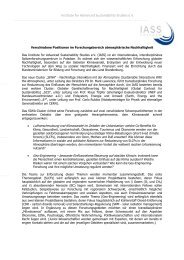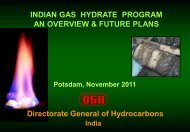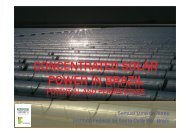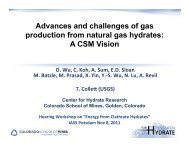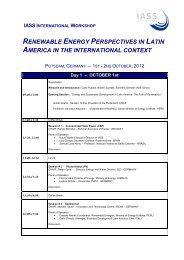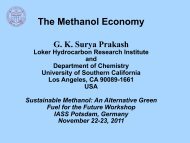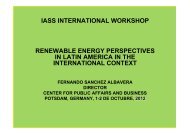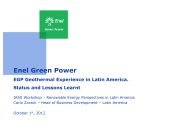Dr. Thomas Reichel - IASS Potsdam
Dr. Thomas Reichel - IASS Potsdam
Dr. Thomas Reichel - IASS Potsdam
- No tags were found...
Create successful ePaper yourself
Turn your PDF publications into a flip-book with our unique Google optimized e-Paper software.
Gas Hydrate as a Resource- Statoil’s Hydrate Initiative<strong>Thomas</strong> <strong>Reichel</strong> & Jarle HusebøExploration Global New Ventures / R&D Explore Unconventionals1 -
Outline• Gas hydrate occurances & resourcepotential• Gas hydrate research in Norway• Statoil’s external collaborations• Statoil’s internal Gas Hydrate Focus• Gas hydrates in NorwayNorwegian SeaBarentsseaSvalbardGas Hydrates– New Value Chain2 -
Gas hydrate occurrances in Northern-Europe?3 -
Statoil interest in Natural Gas Hydrates– Modes of Gas Hydrate Occurrence in NaturePerhaps the major controlling factor on where gas hydrateforms is lithology (sand) and availability of CH 4~400 m water depthPermafrost466Gas migrationfrom depth3251Chimney Structures; veins & nodules112 244234Disseminated pore-fill at base of GHSZStrata-bound deformed clays; veins andnodulesPore-fill sands5Pore-fill in sands with local sourcingGas (C1-C3) migration from depth6Seafloor moundsGas HydrateStability BoundaryHydrate-bearingDeformed ClayMarineClaysHydrate-bearingsandWater-bearingsandFree gasfrom R. Boswell and B. Waite (in prep.)4 -
Gas-hydrate-bearing sands seem the mostfeasible initial targets for energy recovery
The Gas Hydrate Potential in Norway– Gas Hydrate Research Institutes in Norway‣ University in Bergen (Prof. H. Haflidason, Prof. B. Kvamme, Prof, A. Graue)• GANS-Project‣ University in Tromsø (Prof. J. Mienert, <strong>Dr</strong>. S. Buenz)‣ NGU – Norwegian Geological Survey (<strong>Dr</strong>. S. Chand)‣ NGI – Norwegian Geotechnical Institute (<strong>Dr</strong>. T. Kvalstad, <strong>Dr</strong>. M. Vanneste)6 -
Statoil External collaboration partners‣ NDP-Norwegian Deepwater Program• Statoil active member since 1997• Gas hydrate reasearch since early 2000‣ JIP GoM (DOE, Chevron)• Gas hydrate exploration and reservoir analysis‣ UNEP GRID-Arendal• Gas hydrate global outlook‣ RDC GeoEXPLORE (C-Core)• Geoseismic survey offshore New Foundland since 2011• Gas hydrate mapping on existing data‣ LBNL (Prof G. Moridis)• Production simulation studies (Gulf of Mexico)‣ IFM-GEOMAR (Prof K. Wallmann) – Gas Hydrate Basin Modelling• funding of Post-Doc ( planned 2012),‣ University of Bergen• Gas hydrate research funding of student program starting 2012 (Prof B. Kvamme, Prof. A. Graue)7 -
Statoil Internal Gas Hydrate Focus‣ Exploration Technology• Global Screening for Hydrates• R & D Geological and Geophysical Research‣ <strong>Dr</strong>illing & Production Technology• Hydrates as Geohazard during drilling• R & D production strategies from Hydrates• Flow Assurance8 -
9 -Statoil Internal Gas Hydrate Focus
Gas Hydrate Indications on the Mid-NorwayContinental MarginGANS-Project (2006-2010)within NDP-Consortium3 working areas‣ Norwegian continentalmargin‣ Barentssea‣ Western Svalbard Margin10 -
Gas Hydrate Indications on the Mid-NorwayContinental Margin• widespread BSR in seismic data• fluid migration-gas chimneys~ 4000 km 211 -(from NDP-seabed project 2004)
12 -Gas Hydrate Indications on the Mid-NorwayContinental Marginfrom Plaza-Faverola et al. 2010bResults• evidence for thermogenicsources• migration along deep seatedpolygonal faults• gas hydrates act as “broken”seal• Migration can reach seabedto from large ventsites/pockmarksResources• Huge GIP ~ 150-1400 GSm 3• Poor reservoir quality• Low (0,2 GSm 3 /km 2 )resource density,~ comparable to similarhydrate provinces
Gas Hydrate StabilityConditions in theBarents Sea• CH 4 hydrate probably not stable• Presence of BSR and hydratesample suggest thermogenicgas sourceRemaining issues:• Geothermal gradient?• Reservoir?Thickness of GHSZfrom Chand et al. (2008)13 -
Statoil’s Gas Hydrate Initiative in Norway– Shallow gas/gas hydrate exploration in SW Barents Sea (Skrugard)Index map from Laberg & Andreassen (1996); VAMP model from Scholl et al. (2007)14 -
Gas Hydrate potential on SvalbardMilne Point (BP)Mallik (MH21)Svalbard?Messoyakha15 -
Western Svalbard Margin Resource Assessment16 -from Buenz et al (2009)
Western Svalbard Margin Resource Assessment• ~90 m thick GHSZ• Hydrate concentrations (modelled) of up to12 % of pore spacefrom Westbrook et al. (2008)17 -
Gas Hydrate potential on SvalbardPermafrost on SvalbardModelledPermafrostthickness (m)Permafrost in well hole (•)registered in logs (T)‣ up to 600m18 -from Etzelmueller (UiO)
Gas Hydrate potential on Svalbard• Confirmed:− continous permafrost, within GHSZ− assumed good reservoir properties− observations of gas from exploration wells• Unsure:− Traps under the permafrost?− Are sands present along the base of thegas hydrate stability zone?Kapp Laila-1Svalbard Permafrost19 -GHSZ = Gas hydrate stability zone
Gas Hydrate is of Global Significance because1. Of the potential energy resource represented by the large amount ofhydrocarbon trapped in the hydrate phase2. It may play a role in global climate change3. Of the hazard that accumulations of gas hydrate may pose to nearshorecommunities (geo-hazard), drilling and seabed installations(drilling hazard)Global heating?Energy resource?Mega-tsunami20 - Classification: Internal (Restricted Distribution) 2011-09-05
Thank youGas Hydrate as a Resource- Statoil’s Hydrate Initiative<strong>Thomas</strong> <strong>Reichel</strong> & Jarle Husebøthorei@statoil.com, tel: +47 906 89 560www.statoil.com21 -
The Gas Hydrate Potential in Norway– Gas Hydrate Formation Requirements1. Suitable P & T regime2. Petroleum System (gassource, migration path,reservoir & trap)3. Formation waterMarine Basins Permafrost Areas300-600 mSO2-4 reduction & Anaerobic100-300 mGHOSZ Thickness:• Pressure & Temperature• Gas composition• Gas saturation• Salinity• Pore size0.5-1 km (2-20 °C)1 1Several 100s of m (-10-20 °C)1 Hydrate to gas transition22 - Classification: Internal (Restricted Distribution) 2011-05-31Source: Hester & Brewer (2009)




